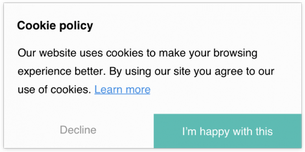Consider this marketing experience: A banner promoting blue-light filtering glasses on an article listing the best books of 2020. Or a video ad for sports equipment that’s shown before a YouTube fitness tutorial. Maybe even text ads for a weekly produce subscription box on the sidebar of a recipe site.
It’s a no-brainer that marketers see the best results when they showcase their brand alongside content that their target audience pursues online. In fact, it’s almost impossible to imagine modern advertising that isn’t based on users’ browsing activities. Enter contextual targeting, the practice of delivering ads that are most relevant to a website’s content.
As companies focus on user privacy , consumer data protection, and opt-in advertising, marketing tools and practices have evolved. As a result, contextual targeting is on the rise, with an expected market of $335.1 billion by 2026 .

An ad for blue-light filtering glasses in the New York Times Book section
Here’s your ultimate refresher on contextual targeting — what it is, how it differs from behavioral targeting, and why it’s more important now than ever.
What is Contextual Targeting?
Contextual targeting is an advertising strategy that involves placing ads on websites or platforms that are contextually relevant to the content being viewed. This form of targeting leverages the context of the webpage, including keywords, topics, and overall content, to deliver ads that are highly targeted and likely to resonate with the audience consuming that specific content. By aligning advertisements with the surrounding content, marketers can increase the chances of capturing the interest of their target audience and driving engagement.
How Does Contextual Targeting Work?
Contextual targeting is relatively easy, especially once you’ve found a reliable ad platform to help launch your ads. Whether your ads are to be watched, heard, or read, start by setting specific parameters for your ads. Typically, you’ll choose between:
Content keywords. What are some specific keywords that aptly describe your product or service? Say you’re running a campaign for a new skincare product, you might select keywords such as “five-step routine,” “2021 moisturizers,” and “vegan skincare.” If you have a prominent, well-recognized brand, you’ll want to pop some branded keywords in there too. Note: This is different from developing keywords based on high search volume terms for SEO.
Content categories. Rather than develop a whole list of keywords (some sites let you choose up to 50!), you’ll simply select appropriate topics for your ad group. Using the same example above, you’ll choose “Beauty & Fitness” and, if available, the subcategory “Face & Body Care.” By selecting broad categories, you can reach a larger audience quickly.
Once you set these parameters, the ad platform’s crawler will scan and categorize the content of different sites based on each web pages’ keywords, phrases, themes, contextual information, and alt text. Whenever a user visits a page, the ad server will match that page’s content with relevant ads.
But wait! Even though your ad may be eligible to be displayed for a particular web page, this doesn’t mean it’s guaranteed to be placed. Other factors, such as language and location targeting, will impact its visibility.

A fashion ad on Elle magazine’s homepage
Pro Tip: The ad tech you choose will play a massive role in your contextual targeting efforts. Platforms with technologies powered by machine learning and artificial intelligence can better understand the sentiment, or even associated imagery, of each website’s content, rather than just scan for keywords, such as what AdRoll’s brand awareness solution provides. The more effective your platform is at digesting a web page’s content, the more accurate your ad matching will be.
Contextual Targeting vs. Behavioral Targeting
It can be easy to confuse contextual and behavioral targeting (sometimes known as audience targeting), which both serve relevant ads to relevant audiences at relevant times. Here’s how they’re different:
When marketers target contextually, the focus is on matching the unique digital environment in which their target audiences are browsing. Even on a single website, say, nytimes.com, the intention and mood of someone reading a recipe are different from someone reading international news. Context-specific ads — a tableware ad for the recipe page versus a hotel booking ad for the international news section — are delivered regardless of who the user is and what other sites they’ve visited.
Comparatively, behavioral targeting works by determining ad placement based on users’ digital behaviors, which are tracked via cookies. This data can include:
Google searches
Clicked links
Browsed product pages
Purchased products
Frequently visited sites
With this information, marketers can then create personalized ads that map onto different audience segments. One popular example of behavioral targeting is retargeting ads , which are entirely personalized and independent from context. In other words, if you see an ad for a leadership course while browsing for a new pair of shoes, that’s behavioral targeting.
Why is Adoption of Contextual Targeting On The Rise?
Since the 2010s, as social media has become an integral part of our lives, personalized advertising has become a reliable tool in digital marketers’ toolboxes. After all, when you’re able to personalize ads that can be delivered to potential customers across sites, you’ll likely see better conversions and click-through rates.
However, with great power comes great responsibility. Digital ads gained the reputation of being spammy when not used properly. People started downloading ad-blockers. Some began asking questions like, “How much data does Facebook have on me?” Lawmakers passed legislation that banned easy behavioral tracking — from the General Data Protection Regulation (GDPR) in Europe to the California Consumer Privacy Act (CCPA) aimed at browser restrictions on cookies.
Marketers needed to pivot fast. Naturally, they turned to contextual targeting.
Why Is Contextual Targeting Important?
On average, people worldwide spend a whopping 2 hours and 24 minutes every day on social media. The value of digital marketing has surged, though it’s become increasingly difficult for brands to successfully break through the noise.
Given new restrictions and regulations, marketers cannot afford to cling to old tools and practices. With behavioral targeting becomes more difficult, the value of contextual targeting in digital advertising cannot be overstated enough.
Here are some reasons why it’s high time to add contextual targeting to your marketing repertoire:
Removal of third-party cookies
In addition to the restriction of third-party cookies on Apple’s Safari and Mozilla’s Firefox, Google has announced the phase-out of third-party cookies on its Chrome browser in 2024. Though users can consent and allow cookies, it’s clear from recent data that browsing behavior is significantly more challenging to collect.
Contextual marketing is not constrained by privacy legislation because it does not track users, collect their data, or target them directly. This makes it safer for advertisers who are worried about steep fines and regulation compliance.

An example of a cookie policy pop up
User privacy
You know that unnerving feeling when an ad follows you from site to site, device to device for days on end? There are many ways to describe this misuse of ad targeting technologies — “creepy,” “annoying,” and “intrusive,” among them. No wonder so many choose to block ads.
With contextual targeting, you can guarantee relevancy and reach without coming off as annoying. That’s because your ad will be relevant to the content that users are currently consuming, instead of appearing random. Even if they’re seeing the ad multiple times on multiple sites, it’s less jarring as it doesn’t feel as “stalker-ish.”
Increased consumption of content
This may sound ludicrous, but marketing experts estimate that most Americans see anywhere between 4,000 to 10,000 daily ads. We’ll ignore most of them, pause for a few, and only click on a handful. In fact, a survey reported that 45% of people “don’t notice online ads anymore, even if I don’t block them.”
It’s clear that with high rates of ad fatigue within the American population, marketers need every tool, resource, and creative idea at their disposal to help their ads cut through the noise.
Luckily, with contextual targeting, you can safely assume that those who come across your ad will show a certain degree of interest given its relevance to the content they’ve chosen to read, watch, or hear. Contextual targeting ensures your brand isn’t falling for the trap of over-personalized (which limits campaign effectiveness) but instead allows users to see ads in the right place and at the right time.
How Much Budget Should I Allocate to Contextual Advertising?
We’ve outlined the pros and cons of both contextual and behavioral targeting. But with limited resources, how should marketers allocate their budgets? Should you cross your fingers and continue tinkering with personalized behavioral targeting? Or should you play it safe and start transitioning to a contextual targeting strategy?
Like many things in this industry, there is no clear-cut answer. The truth is, it’s not even a question of “either-or” — contextual and behavioral targeting can work hand-in-hand and play a role in your digital marketing mix. Look at it this way: Behavioral targeting can help capture the sales of your target audience who have visited your site and perhaps browsed your product. Meanwhile, contextual targeting can be used to boost your broader reach in an affordable way.
Pro Tip: When GDPR took effect, many companies shifted their marketing resources from behavioral to contextual advertising and, surprisingly, saw improved ROI . One reason is that contextual targeting is easier and cheaper to implement, especially if you haven’t already amassed a ton of existing data.
Behavioral targeting relies heavily on customer data, as well as the tools, skills, and experts for analysis and continuous optimization, meaning that brands without this infrastructure in place may fall behind. It may be prudent for brands with limited resources to consider implementing behavioral targeting further down the pipeline.
How Can I Improve The Contextual Ad Performance?
Whichever type of ad targeting you’re opting for, one emotion is universal: the frustration when you’re not getting the clicks you need. The digital landscape is noisy and competitive, with companies vying for the same pool of limited attention. Here are some tips to keep in mind if you want your audience to start giving your ads some love:
Tell a good story. “The more story-appeal there is in the picture or in the photograph, the more people would look at your ad,” said David Ogilvy, one of the greats in advertising. No matter where your ad lives, what you’re selling, or what your budget is, one key ingredient to marketing remains the same: good storytelling. The more impactful and engaging your creative is, the better the results.
Be relevant. Rather than cast a wide net, aim for the most relevant audience possible. It’s the best way to ensure your marketing dollars go to good use.
Do your research. Not all ad tech providers are cast in the same mold. For more on how AdRoll can help with your contextual targeting efforts, check out our features here .
Revamp your landing page. Even if you have a fantastic ad, you probably won’t have high conversion rates if your post-click landing page isn’t optimized. Make sure the ad to product page experience is a seamless and convincing one.
Consider the buyer’s journey. If you’re struggling to develop keywords or choose a category for your ad set, review your buyer’s journey. Who is your target audience, what sites do they spend their time on, and what pages will they browse as they embark on the buyer’s journey?
Think of the whole marketing funnel. Your contextual targeting ads shouldn’t exist in a silo. Make sure they work in tandem with your other efforts, whether it’s content, email, or organic social marketing. They should feel cohesive (without being redundant), relevant, and engaging.
Incorporate Contextual Advertising In Your Marketing Plan
Contextual advertising is a powerful tool that allows you to tailor your marketing messages to the specific interests and needs of your target audience. By analyzing the content of the web pages where your ads are displayed, you can ensure that your message is relevant and engaging to the viewers. This form of advertising not only improves the effectiveness of your campaigns but also enhances the overall user experience by providing valuable and timely information. Integrating contextual advertising into your marketing plan can help you reach your target audience in a more meaningful way, driving higher engagement and conversions.